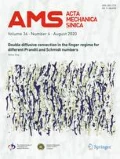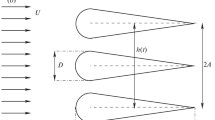Abstract
Simulations have been done to assess the lift, thrust and propulsive efficiency of different types of non-symmetrical airfoils under different flapping configurations. The variables involved are reduced frequency, Strouhal number, pitch amplitude and phase angle. In order to analyze the variables more efficiently, the design of experiments using the response surface methodology is applied. Results show that both the variables and shape of the airfoil have a profound effect on the lift, thrust, and efficiency. By using non-symmetrical airfoils, average lift coefficient as high as 2.23 can be obtained. The average thrust coefficient and efficiency also reach high values of 2.53 and 0.61, respectively. The lift production is highly dependent on the airfoil’s shape while thrust production is influenced more heavily by the variables. Efficiency falls somewhere in between. Two-factor interactions are found to exist among the variables. This shows that it is not sufficient to analyze each variable individually. Vorticity diagrams are analyzed to explain the results obtained. Overall, the S1020 airfoil is able to provide relatively good efficiency and at the same time generate high thrust and lift force. These results aid in the design of a better ornithopter’s wing.
Similar content being viewed by others
Abbreviations
- c :
-
airfoil chord
- C d :
-
drag coefficient
- C l :
-
lift coefficient
- \({\bar {C}_l }\) :
-
average lift coefficient
- C p :
-
pressure coefficient
- C t :
-
thrust coefficient
- \({\bar {C}_t }\) :
-
average thrust coefficient
- f :
-
frequency, Hz
- h :
-
instantaneous heaving position
- \({h'_0 }\) :
-
heaving amplitude
- h 0 :
-
heaving amplitude, non-dimensionalized by airfoil chord
- k :
-
reduced frequency f c/U ∞
- L :
-
lift force
- M :
-
moment created by the lift and drag forces at the pitching axis
- p :
-
pressure
- P :
-
power input
- \({\bar {P}}\) :
-
average power input
- p s :
-
statistical value calculated by Minitab to determine if the variable or interaction is significant
- Re :
-
Reynolds number
- St :
-
Strouhal number \({fh'_0/U_\infty }\)
- t :
-
non-dimensionalized time
- t 0 :
-
time when flapping starts
- T :
-
thrust force
- u b :
-
grid velocity
- u i :
-
Cartesian velocity components
- U ∞ :
-
freestream velocity
- x i :
-
Cartesian coordinates
- θ :
-
instantaneous pitch angle, in degrees
- \({\phi }\) :
-
phase difference between pitching and heaving, in degrees
- θ 0 :
-
pitch amplitude, in degrees
- η :
-
propulsive efficiency
References
Shyy W., Lian Y., Tang J., Liu H., Trizila P., Stanford B., Bernal L., Cesnik C., Friedmann P., Ifju P.: Computational aerodynamics of low Reynolds number plunging, pitching and flexible wings for MAV applications. Acta Mech. Sinica 24, 351–373 (2008). doi:10.1007/s10409-008-0164-z
Koochesfahani M.M.: Vortical patterns in the wake of an oscillating airfoil. AIAA J. 27, 1200–1205 (1989)
Triantafyllou G.S., Triantafyllou M.S., Grosenbaugh M.A.: Optimal thrust development in oscillating foils with application to fish propulsion. J. Fluids Struct. 7, 205–224 (1993)
Taylor G.K., Nudds R.L., Thomas A.L.R.: Flying and swimming animals cruise at a Strouhal number tuned for high power efficiency. Nature 425, 707–711 (2003). doi:10.1038/nature02000
Read D.A., Hover F.S., Triantafyllou M.S.: Forces on oscillating foils for propulsion and maneuvering. J. Fluids Struct. 17, 163–183 (2003)
Hover, F.S., Haugsdal, O., Triantafyllou, M.S.: Effect of angle of attack profiles in flapping foil propulsion. J. Fluids Struct. 19, 37–47 (2004). doi: 10.1016/j.jfluidstructs.2003.10.003
Ramamurti, R., Sandberg, W.: Simulation of flow about flapping airfoils using finite element incompressible flow solver. In: AIAA 37th Aerospace Sciences Meeting and Exhibit, Reno, Nevada, pp. 253–260 (1999)
Wu J.H., Sun M.: The influence of the wake of a flapping wing on the production of aerodynamic forces. Acta Mech. Sinica 21, 411–418 (2005). doi:10.1007/s10409-005-0064-4
Aono H., Shyy W., Liu H.: Near wake vortex dynamics of a hovering hawkmoth. Acta Mech. Sinica 25(1), 25–36 (2009)
Pedro G., Suleman A., Djilali N.: A numerical study of the propulsive efficiency of a flapping hydrofoil. Int. J. Numer. Methods Fluids 42, 493–526 (2003)
Tuncer, I.H., Kaya, M.: Optimization of flapping airfoils for maximum thrust and propulsive efficiency. In: AIAA 41st Aerospace Sciences Meeting, Reno, NV, pp. 2329–2336 (2003)
Mathews, P.: Design of Experiments with MINITAB (2005)
Hirt C.W., Amsden A.A., Cook J.L.: An arbitrary Lagrangian–Eulerian computing method for all flow speeds. J. Comput. Phys. 135, 203–216 (1997)
Kim D., Choi H.: A second-order time-accurate finite volume method for unsteady incompressible flow on hybrid unstructured grids. J. Comput. Phys. 162, 411–428 (2000)
Tay, W.B.: Analysis of non-symmetrical flapping airfoils and their configurations. Ph.D. thesis, National University of Singapore, Singapore (2009)
Balay, S., Buschelman, K., Eijkhout, V., Kaushik, D., Knepley, M.G., McInnes, L.C., Smith, B.F., Zhang, H.: PETSc 2.0 Users Manual: Revision 2.1.5. United States (2004)
Falgout, R.D., Jones, J.E., Yang, U.M.: The design and implementation of hypre, a library of parallel high performance preconditioners. In: Numerical Solution of Partial Differential Equations on Parallel Computers, vol. 51, pp. 267–294. Springer, Berlin (2006)
Pauley L.L., Moin P., Reynolds W.C.: The structure of 2-dimensional separation. J. Fluid Mech. 220, 397–411 (1990)
Young, J.: Numerical simulation of the unsteady aerodynamics of flapping airfoils. Ph.D. thesis, New South Wales University, Canberra (2005)
Tuncer I.H., Kaya M.: Thrust generation caused by flapping airfoils in a biplane configuration. J. Aircr. 40, 509–515 (2003)
Lai J.C.S., Platzer M.F.: Jet characteristics of a plunging airfoil. AIAA J. 37, 1529–1537 (1999)
Mueller T.J., DeLaurier J.D.: Aerodynamics of small vehicles. Ann. Rev. Fluid Mech. 35, 89–111 (2003). doi:10.1146/annurev.fluid.35.101101.161102
Videler J.J., Stamhuis E.J., Povel G.D.E.: Leading-edge vortex lifts swifts. Science 306, 1960–1962 (2004). doi:10.1126/science.1104682
Box G., Behnken D.: Some new three level designs for the study of quantitative variables. Technometrics 2, 455–475 (1960)
Jones, K.D., Castro, B.M., Mahmoud, O., Pollard, S.J., Platzer, M.F., Neef, M., Gonet, K., Hummel, D.: A collaborative numerical and experimental investigation of flapping-wing propulsion. In: AIAA 40th Aerospace Sciences Meeting, Reno, Nevada (2002)
Dallal, G.E.: The Little Handbook of Statistical Practice. http://www.tufts.edu/~gdallal/LHSP.HTM. Accessed 20 March 2007
Author information
Authors and Affiliations
Corresponding author
Rights and permissions
About this article
Cite this article
Tay, W.B., Lim, K.B. Analysis of non-symmetrical flapping airfoils. Acta Mech Sin 25, 433–450 (2009). https://doi.org/10.1007/s10409-009-0259-1
Received:
Revised:
Accepted:
Published:
Issue Date:
DOI: https://doi.org/10.1007/s10409-009-0259-1




